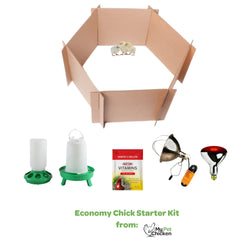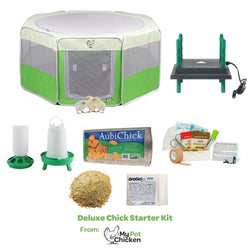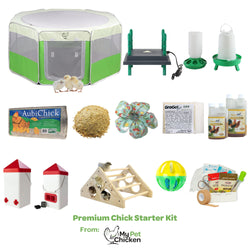Tragedy to Artistry: Appreciating Chicken Feathers
Back to blog
It was crisp and cool, with the pleasant smell of fall in the air, as I walked to my chicken coop. The sun was shining, birds were chirping and the leaves were just beginning to morph into stunning shades of red, gold and orange. What a fantastic morning! My daily routine begins with a quick rake of the run before letting my girls out. As I opened the door to do this, I stopped dead in my tracks. There were chicken feathers EVERYWHERE!

My heart sank and I felt the blood drain from my face. One of the girls must have gotten locked out last night and a "lucky" predator found an easy chicken dinner. But wait... (my thinking brain kicked in)... I was the one who put the flock to bed last night and I KNOW everyone was accounted for. Then I realized... molting season has officially begun!
Even though I've raised chickens for a number of years, I still haven't quite gotten used to this phenomenon and have a brief moment of panic each season. Some chickens lose feathers very slowly over several weeks. This is known as a "soft molt". Others look like they barely survived an explosion at the pillow factory. This is what you call a "hard molt". Learn more about molting.
A five minute chicken feather appreciation primer
Once I survived my mini heart attack, I remembered the one enjoyable thing about molting — the CHICKEN' FEATHERS, of course! We often don't give them much thought, but they are really quite amazing when you take a closer look. Here I'll teach you about the different types of feathers to look for.

Contour feathers
Chicken feathers come in several different types, each with unique functions and characteristics. Contour feathers are typically the most colorful and mostly what you'll see when you look at your chicken. Contour feathers are further subdivided into flight feathers, a.k.a. wing and tail feathers.

Down feathers
Down feathers are smaller than contour feathers, and are much softer and fluffier. Their main purpose is to provide an insulating layer, so they're found closest to the skin. These down feathers are what help to keep them toasty warm on the coldest winter days.

Semi Plume feathers
An intermediate chicken feather with both contour and down feather characteristics is called a semi plume. They also provide insulation and give shape to the chicken.

Filoplumes and Bristle feathers
Filoplumes are thin, hair-like feathers on the body, and bristle feathers are short, stiff feathers found only on the face of chickens.
My Blue Cochin, Greta, experienced a hard molt this year. You can see the progression of her feather growth over a couple of weeks.

Pin feathers
When a chicken's feather first emerges from the skin, it is rolled tightly and encased in a waxy coating. Since they resemble pins sticking out of a pin cushion, they are called "pin" feathers. As feathers grow out, the waxy coating will come off when the birds preen, causing the feathers will unfurl. You may see the remnants of this waxy coating under your roosts.


Chicken feathers in different stages of growth in this photo.
How to help your molting flock
Egg production naturally decreases during molting season, as bodily resources are instead focused on feather regrowth. You can help your chickens' feathers regrow by providing extra protein during the molt. I've had good results with mealworms, black oil sunflower seeds and scrambled eggs.
With all the combinations of chicken feathers, between unique colors and patterns from different breeds, the natural beauty is endless! Decreased egg production is a small, temporary sacrifice I'm willing to endure in exchange for appreciating the natural works of art my flock produces. I encourage you to take a moment to enjoy the beauty your flock produces as well.











